Economia e educação
DOI:
https://doi.org/10.1590/S0102-25551986000100001Abstract
In the discussions that eventually, the author has had eth graduate students in education, it has been observed that in the disciplines of Economics of Education taught to them, the study is restricted to the rate return approach and to the application of methodology of cost-benefit analysis. The purpose of this article is to present the methodology of rate of return at a greater length and to show it as one of a possible set of methodologies, which has been applied by the economists interested in education, including the manpower forecasting approach, the linear programming approach, the screening methodology, the dual market approach, besides the work of the so called radical economists. On the other hand we have assisted a significant change in emphasis on the research aimed at the educational sector. This change in emphasis already detailed in a study by Psacharopoulos in 1976, has also occurred in Brazil. For this reason, the third section is focused on this subject. The final section is an application of cost-benefit analysis to the different professionals produced by U.S.P.. I have limited myself to the calculus of the payback period, due to the difficulty in obtaining the data necessary to derive the rates of return. The calculus I present in this study has the purpose of showing that this methodology can be applied to the educational planning of our university. Surely this potential does exist in the methodologies surveyed and I emphasized in the concluding section that it is necessary to select a methodology and apply it in a coherent and consistent manner.Downloads
Download data is not yet available.


